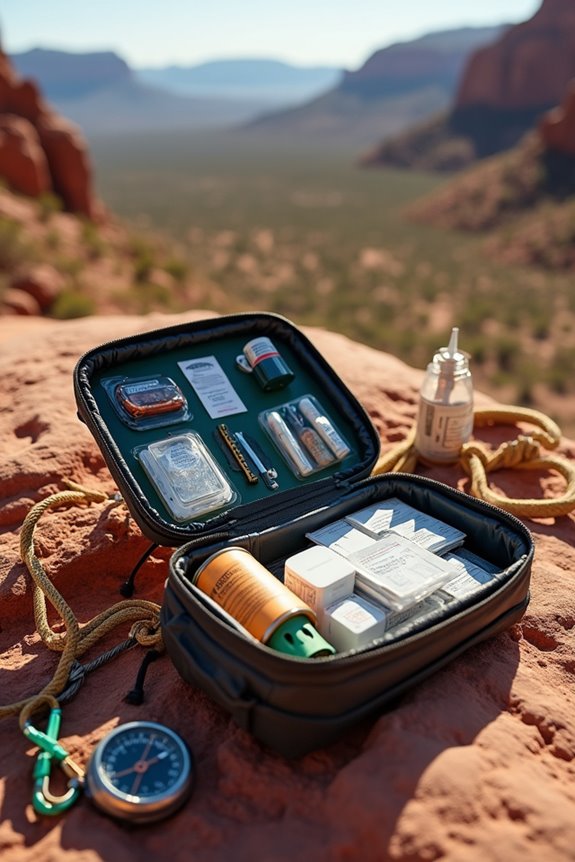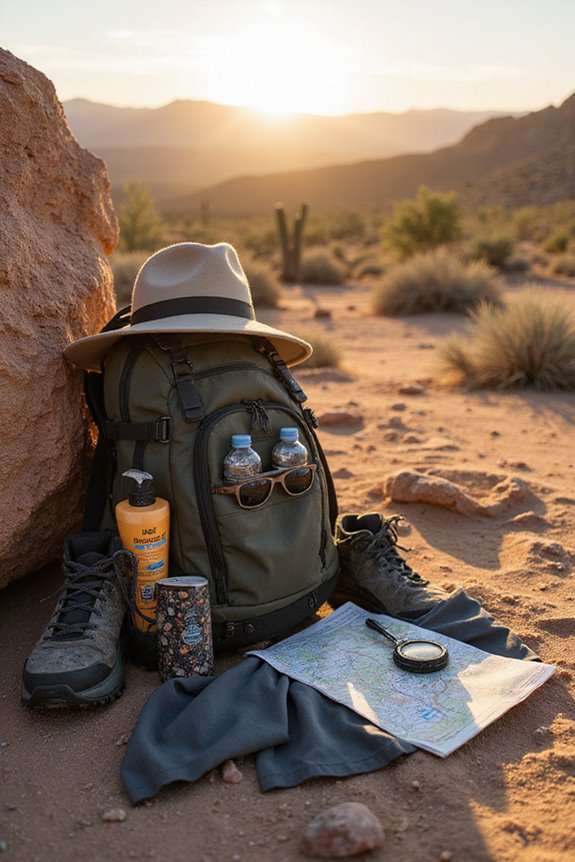When we’re hitting the trails, having a well-stocked first aid kit is a game changer! We need essentials like sterile dressings, pain relievers, and even tweezers for splinters. It’s vital to check expiration dates and keep our kits organized for quick access. Don’t forget to take into account our unique health needs, too. Trust me, being prepared not only gives us peace of mind but can turn a potential crisis into a manageable situation. Stick around, and we’ll dive deeper into creating that perfect kit!
Key Takeaways
- Regularly inspect your first aid kit every six months to replace expired items and ensure all tools are functional.
- Group supplies by function, clearly label each compartment for quick access during emergencies.
- Include essential medications like pain relievers and antidiarrheals, regularly checking their expiration dates.
- Store the kit in an easily accessible, durable container to ensure quick response during emergencies.
- Familiarize yourself with the kit’s contents and practice using it in simulated scenarios to boost confidence.
Importance of First Aid Training
When it comes to adventuring in the great outdoors, having first aid training isn’t just a good idea—it’s essential! We all seek freedom on the trails, but let’s face it: emergencies happen, and knowing first aid can truly be a lifesaver. Think about it—early CPR alone can save thousands of lives each year! By embracing first aid benefits, we become equipped to act decisively and confidently during crises, transforming potentially dire situations into manageable ones.
With training, we build stronger, more prepared communities, ready to help at a moment’s notice. The impact of this training is enormous. So, let’s step up, gain those skills, and come together as knowledgeable adventurers. After all, a little preparation can turn an outdoor journey into a safe, unforgettable experience! Even with the best comprehensive supplies kit, regular checks and replacements of expired items are crucial for ensuring your first aid equipment remains effective when you need it most.
Essential Components of a First Aid Kit
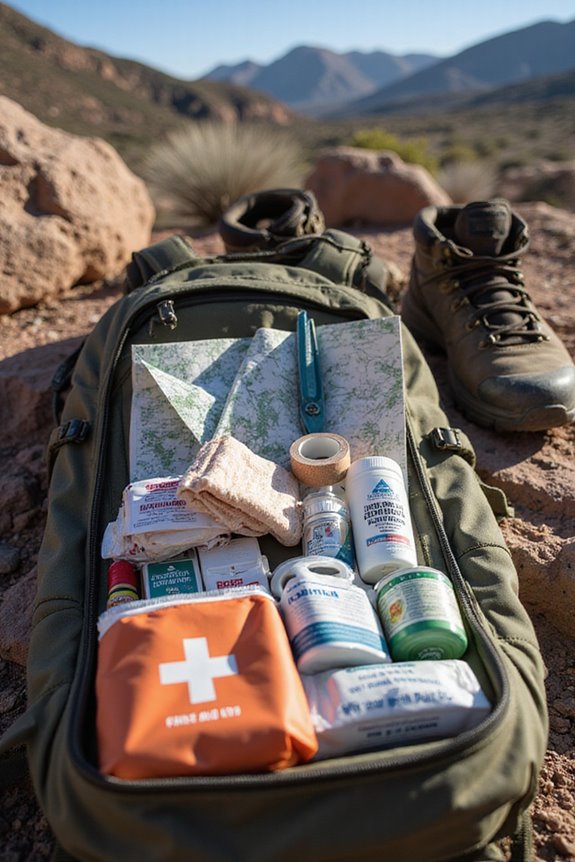
An adventure isn’t truly complete without a well-stocked first aid kit. Whether we’re trekking through the mountains or exploring a new trail, we need to be prepared! Essential components include various wound dressings like sterile gauze pads and hydrogel-based pads for burns. Rolled gauze or kling rolls are fantastic for cushioning and securing our bandage types. We shouldn’t forget hemostatic gauze; it’s a game changer for stopping severe bleeding! Then, there are elastic wraps for sprains, finger splints for fractures, and even medical tape for everything else! Don’t forget gloves and tweezers—they’re lifesavers when we’ve got splinters from those pesky logs. For comprehensive preparedness, consider kits like the EVERLIT 250 Pieces Survival First Aid Kit that weighs only 2 pounds while exceeding OSHA guidelines for first aid essentials. With these supplies, we can tackle our adventures confidently. So, let’s kit up and hit the trails!
Medications and Treatments to Include
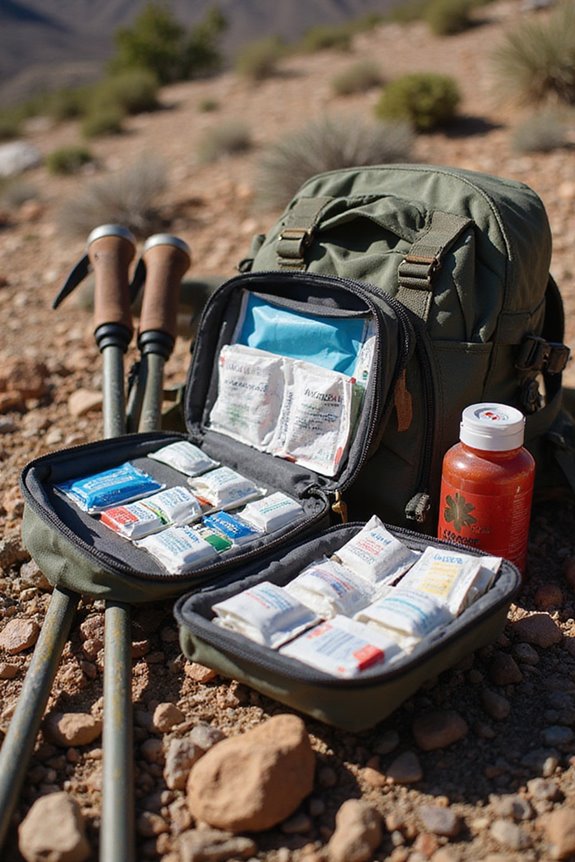
A well-rounded first aid kit isn’t just about bandages and antiseptics; it’s also essential to include an arsenal of medications and treatments to tackle those pesky emergencies that might arise while we’re out exploring. Let’s not forget pain relief medications—acetaminophen for headaches and NSAIDs like ibuprofen for those muscle cramps after a long hike.
For gastrointestinal treatments, it’s smart to pack antacids for heartburn and antidiarrheal meds to keep dehydration at bay, especially while camping. We all know too well that tasty trail mix can sometimes wreak havoc. So, let’s prepare! Regularly check expiration dates and keep those medications stored neatly. Your safety kit should include multi-tools for handling medical emergencies where specialized tools may be needed. With our kit fully stocked, we’re free to enjoy our adventures without the nagging worry of unexpected ailments!
Critical Tools and Supplies for Emergencies

Ready to tackle emergencies on our outdoor adventures? To guarantee we’re fully equipped for whatever nature throws our way, let’s talk about critical supplies for effective emergency preparedness. We need assorted adhesive bandages for minor cuts, sterile gauze for bigger boo-boos, and elastic roller bandages for added support. Blunt-tip shears and tweezers are our friends for safely managing injuries and debris. Don’t forget that flashlight for night-time mishaps — it’s a total lifesaver!
And hey, let’s pack some instant cold packs and gloves, because who wants to deal with infection or swelling? For stabilizing potential fractures on the trail, consider adding a RHINO RESCUE splint that allows for X-rays without removal. With these essential tools in our kit, we’ll be ready to handle any hiccup on our quest for freedom outdoors! Who’s excited? We are!
Steps to Assemble a Family First Aid Kit
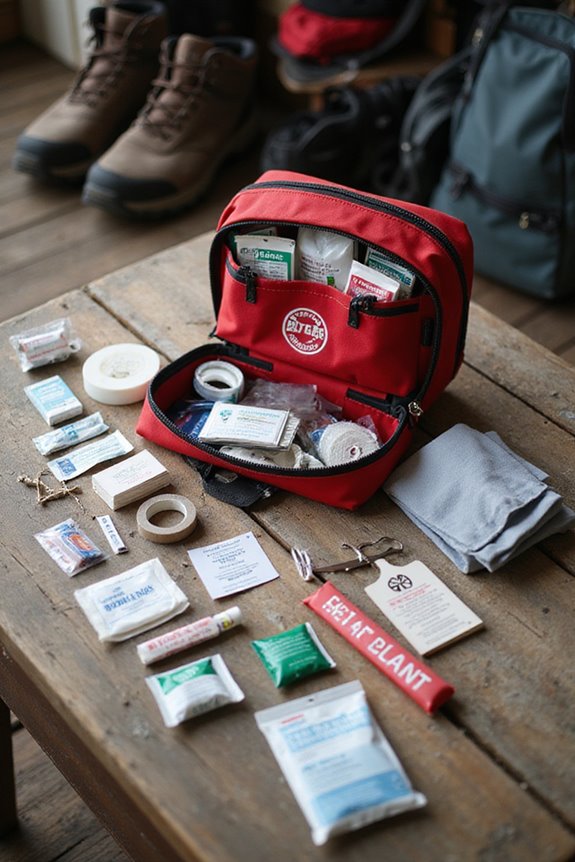
When it comes to assembling a family first aid kit, we’re talking about an essential step in our outdoor adventure prep! First, let’s choose the right container—something durable and easy to carry, like a clear plastic toolbox. It needs to be accessible to everyone in our family, especially during emergencies!
Next, we’ll stock it with basics: adhesive bandages, sterile gauze pads, antiseptic wipes, and non-latex gloves. Don’t forget those over-the-counter pain relievers and any customized meds for specific needs!
Consider adding a compact Protect Life kit that includes 100 pieces specifically designed for outdoor emergencies while maintaining a small footprint in your pack.
Lastly, we should routinely check and replace expired items. Training each family member on how to use the kit not only boosts our confidence but also guarantees we’re ready for any mishap on the trail. Let’s embrace adventure with safety!
Items for Managing Bleeding Injuries
As we hit the trails, preparing for unexpected moments is just as important as packing our favorite snacks. We all love adventure, but let’s be real: sometimes things go sideways! For managing bleeding injuries, our first aid kit should include a reliable tourniquet for those “uh-oh” moments. Trust me, having one handy for tourniquet application can be a lifesaver!
Next up, we can’t forget hemostatic dressings—these are great for speeding up clotting. Some solid compression bandages also help us secure everything tightly, like our hiking pants after a long day! And don’t underestimate chest seals and emergency blankets; they can be vital when things get serious. With our kit ready, we’re not just adventurers; we’re prepared explorers!
Maintenance of Your First Aid Kit
Every few months, it’s important to treat our first aid kit like that beloved hiking buddy we can’t go without—give it some TLC! First, let’s stick to an inspection schedule. A six-month check is key; we examine everything for expiration or damage and replace what’s needed. Remember those storage conditions? Keep our kit in a cool, dry place, away from sunlight and moisture. Trust me, sun-bleached bandages don’t cut it!
While we’re at it, clean the container and verify our tools work. If something looks torn or out of date, toss it! Finally, keep a replacement log so we realize what’s getting low. We want our kit as prepared as we are for the next adventure!
Personalization for Specific Needs
After we’ve given our first aid kit some much-needed love, it’s time to make it truly ours! Let’s customize the kit contents based on our unique needs. If we’ve got allergies, let’s add hypoallergenic gloves and ointments to keep everyone safe. Have kids? Don’t forget pediatric-sized bandages and kid-friendly meds.
For those of us who love sports or outdoor adventures, athletic tape and instant cold packs are essentials! Feeling generous? Toss in lip balm or hand sanitizer for good measure. We all know the trails can get rough, so let’s guarantee we’ve got what we need for every scenario. Personalizing our first aid kit is like creating a safety net, giving us the freedom to explore without worry!
Organizing Your First Aid Kit for Quick Access
Keeping our first aid kit organized is essential—especially when we’re out on the trails and time’s of the essence! Let’s talk container organization—opt for durable, spacious bags with compartments to separate items. Clear containers help us find what we need at a glance, which is key when injuries happen.
We should group supplies by function: think wound care, medications, and emergency tools. Labeling each compartment clearly (waterproof, of course!) guarantees we grab the right stuff quickly.
Keeping Your Kit Updated and Ready
Staying prepared on the trails goes beyond just having an organized first aid kit; we need to keep it fresh and ready for action! Let’s schedule those expiration reminders every six months to review our supplies. We can’t afford to have expired ointments or bandages when adventure calls. Keeping our kit accessible guarantees that it’s within reach, but let’s not forget to store it smartly—away from heat and moisture, of course!
And if we use something, let’s replace it right away. Nobody wants a bare-bones kit after a wild mishap! Regularly reassessing the contents keeps us aligned with our health needs. So, let’s roll up our sleeves and make sure our first aid kit is always ready to tackle whatever nature throws our way!
Frequently Asked Questions
How Often Should I Take a First Aid Training Course?
We should renew our first aid training every three years to guarantee our skills remain sharp. Embracing this first aid frequency allows us all to experience the benefits of confidence and preparedness in emergencies.
Are There Specific First Aid Supplies for Pets?
When it comes to pet first aid, we should always be prepared for animal emergencies. Having essential supplies like gauze, a digital thermometer, and contact numbers guarantees our furry friends get the care they need quickly.
Can I Use Expired Medications in My First Aid Kit?
We can’t use expired medications in our first aid kit. They often lose medication effectiveness and can cause unexpected side effects. Let’s guarantee our supplies are fresh and reliable for any emergency. Safety comes first!
What Should I Do if Someone Is Allergic to Latex Gloves?
If someone shows allergy symptoms from latex gloves, we should remove them immediately, switch to latex alternatives, and monitor closely. If severe reactions occur, let’s call emergency services and stay calm while waiting for help.
How Can I Properly Dispose of Used Medical Supplies From My Kit?
When we’re faced with medical waste from our kit, we must tread carefully! Let’s explore proper disposal methods together: double-bag soiled supplies, utilize sharps containers, and always remember to recycle packaging wisely. Safety matters!

